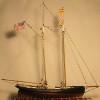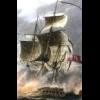-
Posts
8,149 -
Joined
-
Last visited
Reputation Activity
-
 allanyed got a reaction from src in Question on channels and chain plates
allanyed got a reaction from src in Question on channels and chain plates
Brian and Sam
The number and size of bolts varied for size of ship and whether it is the fore, main, or mizzen channel as would be expected. Samples follow:
64 gun 18 gun
Main Channel
Number of bolts 9 7
Bolt diameter 1.25" 7/8"
Iron T-Plates or supports in lieu of wood 6 4
Fore Channel
Number of bolts 8 6
Bolt diameter 1.25" 7/8"
Iron T-Plates or supports in lieu of wood 5 3
Mizzen Channel
Number of bolts 6 5
Bolt diameter 1.125" 7/8"
Iron T-Plates or supports in lieu of wood 3 2
I found no mention of spacing for the bolts or the T-plates.
Allan
-
 allanyed got a reaction from RiverRat in Question on channels and chain plates
allanyed got a reaction from RiverRat in Question on channels and chain plates
Brian and Sam
The number and size of bolts varied for size of ship and whether it is the fore, main, or mizzen channel as would be expected. Samples follow:
64 gun 18 gun
Main Channel
Number of bolts 9 7
Bolt diameter 1.25" 7/8"
Iron T-Plates or supports in lieu of wood 6 4
Fore Channel
Number of bolts 8 6
Bolt diameter 1.25" 7/8"
Iron T-Plates or supports in lieu of wood 5 3
Mizzen Channel
Number of bolts 6 5
Bolt diameter 1.125" 7/8"
Iron T-Plates or supports in lieu of wood 3 2
I found no mention of spacing for the bolts or the T-plates.
Allan
-
 allanyed got a reaction from BETAQDAVE in The American Fishing Schooners: 1825-1935 by Howard Chapelle
allanyed got a reaction from BETAQDAVE in The American Fishing Schooners: 1825-1935 by Howard Chapelle
I have and I use American Fishing Schooners: 1825-1935 By Howard Chapelle regularly. I love this book. If there is one negative for me for this book it is the fact that there is no index that makes sense. There is so much good information in the second half of the book, but none of the key items or words are in the index. Worse still, each item in the main text is presented alphabetically, and not necessarily categorically. Still, I believe this book would enable any builder of an American schooner to do a construct a very accurate and detailed model.
Allan
-
 allanyed got a reaction from JMDoggett in Deja Vu all over again....to copper or not to copper
allanyed got a reaction from JMDoggett in Deja Vu all over again....to copper or not to copper
I had the good fortune to visit the New York Yacht Club a few months back. The models there are spectacular and nary a one has a copper bottom using plate. Those that are coppered are painted and looked great. For warships copper bottoms do look more realistic, but for the dozens of racing yachts, mostly America's Cup winners and challengers, I like the look of the simulated bottom cover. I tried this recently and am pleased with the look on a the yacht Thistle and now on the Fredonia fishing schooner Lettie G. Howard,( pics attached on the Lettie.)
Allan
-
 allanyed got a reaction from augie in How can one make oarlocks?
allanyed got a reaction from augie in How can one make oarlocks?
Ron,
If you go with thole pins you will be in good company. The Fog Warning by Winslow Homer shows pins versus locks .
Allan
-
 allanyed got a reaction from avsjerome2003 in The American Fishing Schooners: 1825-1935 by Howard Chapelle
allanyed got a reaction from avsjerome2003 in The American Fishing Schooners: 1825-1935 by Howard Chapelle
I have and I use American Fishing Schooners: 1825-1935 By Howard Chapelle regularly. I love this book. If there is one negative for me for this book it is the fact that there is no index that makes sense. There is so much good information in the second half of the book, but none of the key items or words are in the index. Worse still, each item in the main text is presented alphabetically, and not necessarily categorically. Still, I believe this book would enable any builder of an American schooner to do a construct a very accurate and detailed model.
Allan
-
 allanyed got a reaction from mtaylor in What were the lengths of cannons (gun) barrels?
allanyed got a reaction from mtaylor in What were the lengths of cannons (gun) barrels?
Brian Lavery's Arming and Fitting English Ships of War gives a lot of information on British armament. Adrian Caruana's History of English Sea Ordinance is probably the best source of detailed information. Wish I had a copy of this two volume set!
Allan
-
 allanyed got a reaction from hopeful in Deja Vu all over again....to copper or not to copper
allanyed got a reaction from hopeful in Deja Vu all over again....to copper or not to copper
I had the good fortune to visit the New York Yacht Club a few months back. The models there are spectacular and nary a one has a copper bottom using plate. Those that are coppered are painted and looked great. For warships copper bottoms do look more realistic, but for the dozens of racing yachts, mostly America's Cup winners and challengers, I like the look of the simulated bottom cover. I tried this recently and am pleased with the look on a the yacht Thistle and now on the Fredonia fishing schooner Lettie G. Howard,( pics attached on the Lettie.)
Allan
-
 allanyed got a reaction from WackoWolf in HMS Blanche 1800 by robbl - 1/48 - POF - was HMS Euryalus 1803
allanyed got a reaction from WackoWolf in HMS Blanche 1800 by robbl - 1/48 - POF - was HMS Euryalus 1803
Rob,
I cannot tell you how much fun it is to watch your build, along with Egen and anyone doing Euryalus or other ships in the class. Careful with the stern timbers. I waited until much later to set them in place as I was worried about knocking them off before before they were fully framed and the counter planking completed.
Great job, and thanks again for sharing
Allan
-
 allanyed got a reaction from butch in HMS Naiad 1797 by EdT - FINISHED - 1:60 - 38-gun frigate
allanyed got a reaction from butch in HMS Naiad 1797 by EdT - FINISHED - 1:60 - 38-gun frigate
Ed,
As much as I enjoyed following your log the first time, I am enjoying it more the second time around
Thanks for going to the trouble to repost.
Allan
-
 allanyed got a reaction from JesseLee in Belaying Pins
allanyed got a reaction from JesseLee in Belaying Pins
Some folks find making trennals or blocks tedious. I don't like belaying pins. If made of wood and to scale they are hard to make and weak, even using a good strong wood such as boxwood. Turning them from metal is difficult, even with a mini lather. Store bought are invariably not to scale, or if made of metal and to scale, pretty expensive.
I came up with an idea some of you may like to try. This has probably been done before, but I had not seen it and so far I am not unhappy with the results for making these for my current schooner project.
You will need the following:
Small drill press or Dremel that can be held in a clamping device
Brass tubing
Brass rod that is the same diameter as the tube inside diameter
Jeweler files
Silver solder
Pickling solution
Oxidizing agent
Chuck a short piece of tubing in the press or in the Dremel type drill.
Shape the handle with the jeweler files
Cut off the handle for the tube and make another and another.......
Cut the rod so it goes the entire length into the tube and extends out the proper length
Place a tiny tab of silver solder paste into the tube
Insert the rod into the tube
Heat the piece until the solder melts
Clean in a pickling solution for 5 or 10 minutes until it is clean
Oxidize with Blacken It or other agent. I use a diluted solution (about 6 or 8 to 1) Keep it in until it turns a brownish color to simulate wood, or if your vessel has iron pins, keep it in until black.
Hope this helps others that are not happy with other methods. Sorry the pics are not in the proper order
-
 allanyed got a reaction from Matrim in HBMS Amphion 1798 by Matrim - 32 Gun 18pdr Frigate
allanyed got a reaction from Matrim in HBMS Amphion 1798 by Matrim - 32 Gun 18pdr Frigate
Joss,
There seems to be a line missing. I have attached a sketch identifying the timbers. If my sketch is incorrect, Wayne or someone please step in as I do not want to lead Joss down the wrong path.
Allan
-
 allanyed got a reaction from trippwj in 18th Century Model Builders
allanyed got a reaction from trippwj in 18th Century Model Builders
The photo is of the paper written by George Stockwell who built the model of the HMS Bristol and found in the model as pointed out by Greg in an earlier post on this thread. I am not sure, but it may still be on loan to the Art Gallery of Toronto.
The note says This model was made May the 7, 1774 By Geo Stockwell Shipwright at Sheerness Yard
This is actually a copy of the original and put on display with the model.
Allan
-
 allanyed got a reaction from WackoWolf in How do I cut a hooked scarph joint
allanyed got a reaction from WackoWolf in How do I cut a hooked scarph joint
Erik
I normally cut one piece then lay it on the second piece and with a sharp point, mark the matching line. Cut short of the marked line, test fit, then trim with a chisel or other sharp blade and test fit again and trim and test until it is a perfect fit. It is easy, albeit takes a little time and patience.
Allan
-
 allanyed got a reaction from rlb in Belaying Pins
allanyed got a reaction from rlb in Belaying Pins
Some folks find making trennals or blocks tedious. I don't like belaying pins. If made of wood and to scale they are hard to make and weak, even using a good strong wood such as boxwood. Turning them from metal is difficult, even with a mini lather. Store bought are invariably not to scale, or if made of metal and to scale, pretty expensive.
I came up with an idea some of you may like to try. This has probably been done before, but I had not seen it and so far I am not unhappy with the results for making these for my current schooner project.
You will need the following:
Small drill press or Dremel that can be held in a clamping device
Brass tubing
Brass rod that is the same diameter as the tube inside diameter
Jeweler files
Silver solder
Pickling solution
Oxidizing agent
Chuck a short piece of tubing in the press or in the Dremel type drill.
Shape the handle with the jeweler files
Cut off the handle for the tube and make another and another.......
Cut the rod so it goes the entire length into the tube and extends out the proper length
Place a tiny tab of silver solder paste into the tube
Insert the rod into the tube
Heat the piece until the solder melts
Clean in a pickling solution for 5 or 10 minutes until it is clean
Oxidize with Blacken It or other agent. I use a diluted solution (about 6 or 8 to 1) Keep it in until it turns a brownish color to simulate wood, or if your vessel has iron pins, keep it in until black.
Hope this helps others that are not happy with other methods. Sorry the pics are not in the proper order
-
 allanyed got a reaction from tkay11 in Belaying Pins
allanyed got a reaction from tkay11 in Belaying Pins
Some folks find making trennals or blocks tedious. I don't like belaying pins. If made of wood and to scale they are hard to make and weak, even using a good strong wood such as boxwood. Turning them from metal is difficult, even with a mini lather. Store bought are invariably not to scale, or if made of metal and to scale, pretty expensive.
I came up with an idea some of you may like to try. This has probably been done before, but I had not seen it and so far I am not unhappy with the results for making these for my current schooner project.
You will need the following:
Small drill press or Dremel that can be held in a clamping device
Brass tubing
Brass rod that is the same diameter as the tube inside diameter
Jeweler files
Silver solder
Pickling solution
Oxidizing agent
Chuck a short piece of tubing in the press or in the Dremel type drill.
Shape the handle with the jeweler files
Cut off the handle for the tube and make another and another.......
Cut the rod so it goes the entire length into the tube and extends out the proper length
Place a tiny tab of silver solder paste into the tube
Insert the rod into the tube
Heat the piece until the solder melts
Clean in a pickling solution for 5 or 10 minutes until it is clean
Oxidize with Blacken It or other agent. I use a diluted solution (about 6 or 8 to 1) Keep it in until it turns a brownish color to simulate wood, or if your vessel has iron pins, keep it in until black.
Hope this helps others that are not happy with other methods. Sorry the pics are not in the proper order
-
 allanyed got a reaction from maso in Belaying Pins
allanyed got a reaction from maso in Belaying Pins
Some folks find making trennals or blocks tedious. I don't like belaying pins. If made of wood and to scale they are hard to make and weak, even using a good strong wood such as boxwood. Turning them from metal is difficult, even with a mini lather. Store bought are invariably not to scale, or if made of metal and to scale, pretty expensive.
I came up with an idea some of you may like to try. This has probably been done before, but I had not seen it and so far I am not unhappy with the results for making these for my current schooner project.
You will need the following:
Small drill press or Dremel that can be held in a clamping device
Brass tubing
Brass rod that is the same diameter as the tube inside diameter
Jeweler files
Silver solder
Pickling solution
Oxidizing agent
Chuck a short piece of tubing in the press or in the Dremel type drill.
Shape the handle with the jeweler files
Cut off the handle for the tube and make another and another.......
Cut the rod so it goes the entire length into the tube and extends out the proper length
Place a tiny tab of silver solder paste into the tube
Insert the rod into the tube
Heat the piece until the solder melts
Clean in a pickling solution for 5 or 10 minutes until it is clean
Oxidize with Blacken It or other agent. I use a diluted solution (about 6 or 8 to 1) Keep it in until it turns a brownish color to simulate wood, or if your vessel has iron pins, keep it in until black.
Hope this helps others that are not happy with other methods. Sorry the pics are not in the proper order
-
 allanyed got a reaction from SteveM in HMS Naiad 1797 by EdT - FINISHED - 1:60 - 38-gun frigate
allanyed got a reaction from SteveM in HMS Naiad 1797 by EdT - FINISHED - 1:60 - 38-gun frigate
Ed,
As much as I enjoyed following your log the first time, I am enjoying it more the second time around
Thanks for going to the trouble to repost.
Allan
-
 allanyed got a reaction from robbl in Euryalus
allanyed got a reaction from robbl in Euryalus
Bob at Seawatch informed me that all domestic (US) orders for volume II have shipped and international orders will ship today, February 16, 2013.
Thank you very much to all that have made the investment in these books.
With many thanks and kindest regards,
Allan
-
 allanyed got a reaction from trippwj in Euryalus
allanyed got a reaction from trippwj in Euryalus
Bob at Seawatch informed me that all domestic (US) orders for volume II have shipped and international orders will ship today, February 16, 2013.
Thank you very much to all that have made the investment in these books.
With many thanks and kindest regards,
Allan
-
 allanyed got a reaction from Chuck in Euryalus
allanyed got a reaction from Chuck in Euryalus
Bob at Seawatch informed me that all domestic (US) orders for volume II have shipped and international orders will ship today, February 16, 2013.
Thank you very much to all that have made the investment in these books.
With many thanks and kindest regards,
Allan















